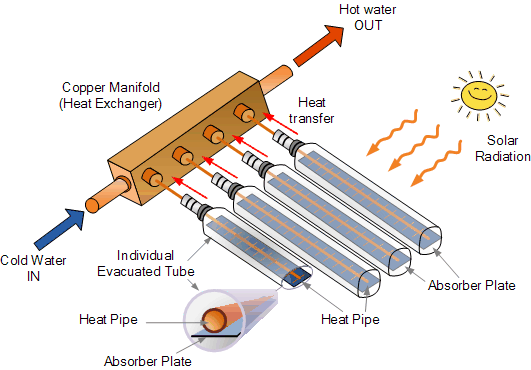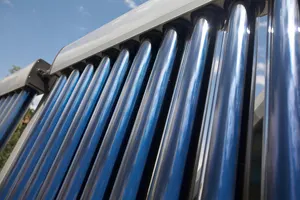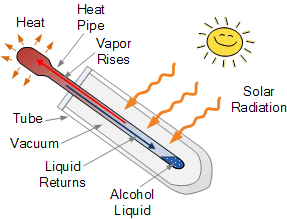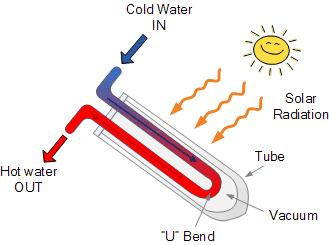
Evacuated Tube Collector
Solar Evacuated Tube Collectors for Hot Water
![]() The evacuated tube collector (ETC) consists of a number of sealed glass tubes which have a thermally conductive copper rod or pipe inside allowing for much high thermal efficiency and working temperature compared to the flat plate solar collectors even during a freezing cold day.
The evacuated tube collector (ETC) consists of a number of sealed glass tubes which have a thermally conductive copper rod or pipe inside allowing for much high thermal efficiency and working temperature compared to the flat plate solar collectors even during a freezing cold day.
In the previous tutorial we looked at Solar Flat Plate Collectors and saw that they consist of a blackened metal absorber plate and water pipes enclosed within a sealed glazed and insulated metal (or wooden) box. Pipes called riser, soldered to the absorber plate carry liquid that is heated by the sun and in a direct heating system, water is heated as it circulates through the panels to the storage tank. In indirect systems, the sun’s energy heats a glycol/water mixture that cannot freeze and which, in turn, heats the water in the tank.
While this type of solar hot water systems is cheap and easy to install, the problem with flat plate collectors is that they are “flat”. This produces one limitation to their efficiency as they can only operate at maximum efficiency when the sun is directly overhead at midday. At other times, the sun’s rays are striking the collector at varying angles bouncing off the glazing material thereby reducing their efficiency.
Solar hot water systems that use Evacuated Tube Collectors as their heat source overcome this problem because the solar collector uses individual rounded tubes which are always perpendicular to the sun’s rays for most of the day. This allows a solar hot water system using an evacuated tube collector to operate at a much high efficiency and temperature for a much longer period than a conventional single flat plate collector installed system.
Also, another advantage of solar evacuated tube technology is that the weight and roof structural problems caused by standard flat plate systems are eliminated as the solar tubes are not filled with large amounts of heavy water.
Solar Evacuated Tube Collector

The Evacuated tube collector consists of a number of rows of parallel transparent glass tubes connected to a header pipe and which are used in place of the blackened heat absorbing plate we saw in the previous flat plate collector.
These glass tubes are cylindrical in shape. Therefore, the angle of the sunlight is always perpendicular to the heat absorbing tubes which enables these collectors to perform well even when sunlight is low such as when it is early in the morning or late in the afternoon, or when shaded by clouds. Evacuated tube collectors are particularly useful in areas with cold, cloudy wintry weathers.
So how do solar evacuated tube collectors work?. Evacuated tube collectors are made up of a single or multiple rows of parallel, transparent glass tubes supported on a frame. Each individual tube varies in diameter from between 1" (25mm) to 3" (75mm) and between 5′ (1500mm) to 8′ (2400mm) in length depending upon the manufacturer.
Each tube consists of a thick glass outer tube and a thinner glass inner tube, (called a “twin-glass tube”) or a “thermos-flask tube” which is covered with a special coating that absorbs solar energy but inhibits heat loss. The tubes are made of borosilicate or soda lime glass, which is strong, resistant to high temperatures and has a high transmittance for solar irradiation.
Unlike flat panel collectors, evacuated tube collectors do not heat the water directly within the tubes. Instead, air is removed or evacuated from the space between the two tubes, forming a vacuum (hence the name evacuated tubes).
This vacuum acts as an insulator reducing any heat loss significantly to the surrounding atmosphere either through convection or radiation making the collector much more efficient than the internal insulating that flat plate collectors have to offer. With the assistance of this vacuum, evacuated tube collectors generally produce higher fluid temperatures than they’re flat plate counterparts so may become very hot in summer.
Evacuated Tube Collector

Inside the each glass tube, a flat or curved aluminium or copper fin is attached to a metal heat pipe running through the inner tube. The fin is covered with a selective coating that transfers heat to the fluid that is circulating through the pipe. This sealed copper heat pipe transfers the solar heat via convection of its internal heat transfer fluid to a “hot bulb” that indirectly heats a copper manifold within the header tank.
These copper pipes are all connected to a common manifold which is then connected to a storage tank, thus heating the hot water during the day. The hot water can then be used at night or the next day due to the insulating properties of the tank.
The insulation properties of the vacuum are so good that while the inner tube may be as high as 150oC, the outer tube is cooler to touch. This means that evacuated tube water heaters can perform well and can heat water to fairly high temperatures even in cold weather when flat plate collectors perform poorly due to heat loss.
However, the downside of using evacuated tubes is that the panel can be a lot more expensive compared to standard flat plate collectors or solar batch collectors. Evacuated tube solar collectors are well suited to commercial and industrial hot water heating applications and can be an effective alternative to flat plate collectors for domestic space heating, especially in areas where it is often cloudy.
Evacuated tube collectors are overall more modern and more efficient compared to the standard flat plate collectors as they can extract the heat out of the air on a humid, dull overcast days and do not need direct sunlight to operate. Due to the vacuum inside the glass tube, the total efficiency in all areas is higher and there is a better performance even when the sun is not at an optimum angle.
For these types of solar hot water panels, the configuration of the vacuum tube is what’s really important. There are a few different vacuum tube configurations, single wall tube, double wall tube, direct flow or heat pipe, and these differences can determine how the fluid is circulated around the solar hot water panel.
Heat Pipe Evacuated Tube Collectors
In heat pipe evacuated tube collectors, a sealed heat pipe, usually made of copper to increase the collectors efficiency in cold temperatures, is attached to a heat absorbing reflector plate within the vacuum sealed tube. The hollow copper solar heat exchanger design within the tube is evacuated of air but contains a small quantity of a low pressure alcohol/water liquid plus some additional additives to prevent corrosion or oxidation.

This vacuum enables the liquid to vapourise at very lower temperatures than it would normally at atmospheric pressure. When sunlight in the form of solar radiation hits the surface of the absorber plate inside the tube, the liquid in the heat pipe quickly turns into a hot vapour type gas due to presence of the vacuum. As this gas vapour is now lighter, it rises up to the top portion of the pipe heating it up to a very high temperature.
The top part of the heat pipe, and therefore the evacuated tube is connected to a copper heat exchanger called the “manifold”. When the hot vapours still inside the sealed heat tube enters the manifold, the heat energy of the vapour is transferred to the water or glycol fluid flowing through the connecting manifold. As the hot vapour looses energy and cools, it condenses back from a gas to a liquid flowing back down the heat pipe to be reheated.
The heat pipe and therefore the evacuated tube collectors must be mounted in such a way as to have a minimum tilt angle (around 30o) in order for the internal liquid of the heat pipe to return back down to the hot absorber plate at the bottom of the tube. This process of converting a liquid into a gas and back into a liquid again continues inside the sealed heat pipe as long as the sun shines.
The main advantage of Heat Pipe Evacuated Tube Collectors is that there is a “dry” connection between the absorber plate and the manifold making installation much easier than with direct flow collectors. Also, in the event an evacuated tube cracking or breaking and the vacuum becoming lost the individual tube can be exchanged without emptying or dismantling the entire system. This flexibility makes heat pipe evacuated tube solar hot water collectors ideal for closed loop solar designs as the modular assembly allows for easy installation and ability to easily expand by adding as many tubes as you want.
Direct Flow Evacuated Tube Collector
Direct flow evacuated tube collectors also known as “U” pipe collectors, are different from the previous ones in that they have two heat pipes running through the centre of the tube. One pipe acts as the flow pipe while the other acts as the return pipe. Both pipes are connected together at the bottom of the tube with a “U-bend”, hence the name.
The heat absorbing reflective plate acts like a dividing strip which separates the flow and the return pipes through the solar collector tubes. The absorber plate and the heat transfer tube are also vacuum sealed inside a glass tube providing exceptional insulation properties.

The hollow heat pipes and the flat or curved reflector plate are made out of copper with a selective coating to increase the collectors overall efficiency. This particular evacuated tube configuration is similar in operation to the flat plate collectors, with the exception of the vacuum provided by the outer tube.
Since the heat transfer fluid flows into and out of each tube, direct flow evacuated tube collectors are not as flexible as the heat pipe types. If a tube cracks or breaks it can not be easily replaced. The system will require draining as there is a “wet” connection between the tube and manifold.
Many solar industry professionals believe that direct flow evacuated tube designs are more energy efficient than heat pipe designs, because with direct flow, there isn’t a heat exchange between fluids. Also, in an all-glass direct flow construction the two heat tubes are placed one inside the other so the fluid being heated passes down the middle of the inner tube and then back up through the outer absorber tube.
Direct flow evacuated tubes can collect both direct and diffuse radiation and do not require solar tracking. However, various parabolic trough reflector shapes placed behind the tubes are sometimes used to usefully collect some of the solar energy, which may otherwise be lost, thus providing a small amount of solar concentration.
Other Considerations when using Evacuated Tube Collectors
Due to the sealed vacuum within their design, evacuated tube collectors can get very hot, exceeding the boiling point of water during the hot summer months. These high temperatures can cause significant issues in an existing domestic solar hot water system such as overheating and cracking of the evacuated glass tubes.
To help prevent this from happening in hot summer climates, bypass valves and large heat exchangers are used to “dump” the excess heat as well as mixer valves which mix regular (cool) water with the hot water, to ensure that the temperature and pressure levels never exceed some pre-set limit.
Also, heat pipe collectors should never be exposed to direct sunlight without a heat transfer fluid flowing through the heat exchanger. Doing so will cause the empty heat exchanger to become extremely hot and which may crack due to the sudden shock once cold water begins to flow through it.
Even though evacuated tube collectors are capable of heating water to +50 degrees Celsius in the winter, the outer glass tube of an evacuated tube does not heat up like a normal flat plate solar collectors when in use. This is due to the inherent insulation properties of the vacuum inside the tube which prevents the outer heat tube from being cooled by the outside ambient temperature which can be well below freezing.
Thus in the colder winter months, these types of collectors can not melt away the large quantity of snow that falls on them at any one time which means clearing the snow and ice from the glass tubes daily can be a problem without breaking them.
Even if it is very snowy or very cold, enough sunlight will get through to keep the tubes well above freezing and still be able to preheat the water which can then be heated further by a standard electrical immersion heater or gas burner reducing the costs of heating the water in winter.
The Evacuated Tube Collector is a very efficient way of heating much of your hot water use just using the power of the sun. They can achieve high very temperatures but are more fragile than other types of solar collectors and are much more expensive to install. They can be used in either an active open-loop (without heat exchanger) or an active closed-loop (with heat exchanger) solar hot water system but a pump is required to circulate the heat transfer fluid from collector to storage in order to stop it from overheating.
In our next tutorial about Solar Heating, we will look at another way of heating water using a type of batch collector known commonly as an Integral Collector Storage system or ICS, and see how they can be used to both generate and store the solar hot water.











Have you seen sytems using these evacuated tube collectors used in conjuction with a stirling pump? In high temp climates could the pump be used as a heat exchanger and generate electricity as a by product?
Is there really no market for thermosiphon compatible solar tubes, with water supply on the bottom and the outflow on the top?
I have a system I really really really want to use this type of evacuated tube for but I can’t find them anywhere and it’s starting to get depressing.
I live on the edge of a cloud forest, so for six months of the year it is essentially foggy, so it seems an open loop vacuum tube system is my best option. If I collect actual meteorological data (I have a weather station… 🙂 ) such as sun insolation from the site in question will it be reasonable to expect a contractor to be able to properly size and design and price a system based on that data?
Absolutely, To ensure that any renewable technology system whether, solar, wind, or thermal get used to their best advantage and to guarantee a quick return on investment, collecting local meteorological data from a particular site daily, weekly, or monthly, is important at the pre-planning stage.
This should allow your contractor(s), if he/she is any good, to estimate how much useful energy the system will provide in an average year, and its monetary value. This should make the final result more robust and understandable when designing a system for your location, reducing errors in energy prediction. Also, your local library, town hall, the internet, or contractor may already have historical data and solar radiation levels relating to your location.